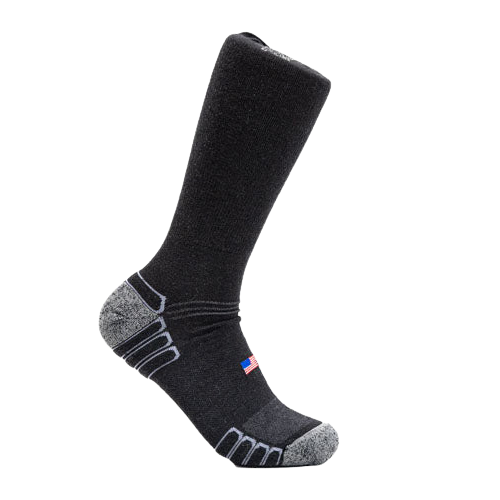Wearing wool socks in the winter is obvious---most people know that wool is a great insulator and they can’t wait to throw on their cozy socks and kick it next to the fireplace.
But I actually first fell in love with wool socks when I found out they kept my feet cooler and more dry throughout the summer. That’s when I became a convert.
Funny story about how it happened, too. I’ll tell you all about it. And I'll share what the best lightweight wool socks are, too.
5 Reasons You Should Be Wearing Wool Socks All Summer
In college, I’d spend the summers doing construction and renovation projects to pay for my tuition. I’d gotten in with a crew where we’d do these huge projects that would take 2 months---14 hours a day, 7 days a week.
One project was a condo complex in a ski-resort town in California. I packed everything I had for the several month journey in a small backpack and figured that’d be good.
It was a hot summer, and one day I was down to my last pair of socks: they were my wool pair I brought just in case it got cold for some reason. I’d been wearing my light cotton socks the whole time thinking those were the best choice.
And when I finished work that day, I was surprised to find that for the first time during the whole project, my feet weren’t sweaty and wrinkly.
They were completely dry and comfortable. And now I know why. Science actually backs up the fact that Merino wool socks are the best type of sock to wear in summer. And there are 5 fascinating reasons why.
1. Wool Wicks Sweat Better Than Both Cotton and Polyester
Wool is 25% more efficient at wicking sweat compared to polyester, and it’s 15% better than cotton.
What’s crazy is that most “sweat wicking” socks you find available today are polyester. It’s a blatant lie.
Sure, polyester wicks sweat---all fabric does. But polyester is terrible at keeping your feet dry, especially when compared to Merino wool.
It might come as a surprise, but wool is the best sweat wicking fabric commonly available. So if you struggle with sweaty feet, try wool socks. They’re game changing.
2. Wool Absorbs 35% of Its Weight in Moisture Before Feeling Wet
Compare this fatty 35% to cotton’s 14% and polyester’s measly 1%.
But what does it mean?
Let’s look at polyester. With a 1% moisture uptake, it basically means that as soon as your feet start sweating, you’ll feel it. Wet fabric can stick and rub, which can cause blisters.
Or you just walk around with swampy feeling feet all day, which sucks.
Cotton does a better job, with a 14% moisture uptake. You’ll get an extra few hours of dry-feeling feet before you start to notice your feet sweating. Cotton can soak up a lot more of that delicious foot moisture before it starts to get uncomfortable.
But then you look at wool. Merino wool has a 35% moisture uptake, which is dramatically better than both cotton and polyester (honestly, polyester is a joke fabric).
Most people who wear wool socks notice that they never feel like their feet are sweaty or wet. In some cases, people who struggle with extreme foot sweat (it’s a thing) may start to notice a wet feeling about 8 hours into a hot summer work day. But when you compare that to the same feeling within 30 minutes for polyester and 2 hours for cotton, the winner is clear.
3. Wool is More Odor Resistant
So I thought this was pretty funny. There was literally a study done where they had 13 “skilled olfactory sensors” do a sniff test on dirty socks.
Yes, they got 13 people with great noses to inhale the unholy vapors of some used socks. Not what they tell you being a scientist is like in elementary school, eh?
What they found was surprising:

Wool was a little stinky after some massive man-hunk took off his socks for the day. The odor raters scored wool about a 25 out of 100 on the stank-scale.
The same sniffers smelled those socks 7 days later and again 28 days later. The score rose from a 25 to a 27---very little difference over time.
Cotton’s initial smell score was a 30---not too much worse than wool. But at the 7 day and 28 day mark, the cotton socks kept getting stinkier and stinkier.
And then there’s polyester: day 1, polyester socks scored a 67 on the stink-meter---over twice as smelly as wool and cotton. And then it continued to get worse on day 7 and 28.
When polyester socks topped out at a score of 83, they had to stop the test because “skilled olfactory sensors” started saying hey, you’re not paying me enough for this s*%&.
Ok, maybe I added that for dramatic effect, but the data points to the obvious: wool socks smell better after you wear them when compared to cotton and polyester.
But why did the smell get worse over time? Well, that points to another reason why wool is better for hot summer days.
4. Wool is Bacteria Resistant
You’ll notice on the graph above that wool didn’t get significantly more smelly over the 28 days they were stored without washing.
I don’t recommend wearing your Camel City Mill socks for 28 days straight, but even if you did, no one would kick you off the job site for having stinky feet.
Cotton had a marked increase at 7 days and then a slight increase again at 28 days. To me, this says you need to wash your cotton socks pretty quickly after wearing them---they pick up the most bacteria when they’re still retaining moisture from your foot. But after they fully dry, they don’t really get much more stinky.
Polyester basically acts as a petri dish for bacteria and starts smelling basically as soon as you put your boots on. 7 days later, the stank is terrible. 28 days later...well...they made a zombie movie about that.

5. Merino Wool Creates a Dry Barrier
This only applies to Merino wool socks like the Camel City Mill Lightweight. Because of the structure and fine knit of Merino wool, the fabric actually repels moisture from humid environments.
A lot of studies have been done that show Merino wool socks as beneficial for people with eczema, but even if you don’t have skin issues with your feet, all evidence points to dryer, more healthy feet with Merino wool socks.
A few years ago, I got athlete's foot, which absolutely sucks. Because athlete’s foot is a fungal issue, you need to keep your feet dry as much as possible. Wool socks are clutch here.
And the dry barrier Merino wool creates will also help prevent issues like athlete’s foot, too.
So if you weren’t freaked by the smelly sock zombie pic above, I’m thinking foot fungus might be what turns you.
Suns Out, Merino Wool Socks Out
I’ve had some terrible experiences with socks. And most of the time it’s because I wore socks that made my feet sweat and smell.
Working on my feet for 14 hours a day, I’d peel off my socks to white, shriveled, wrinkly, smelly feet.
I needed a sock I could depend on---something that was durable enough to last 14 hour shifts, 7 days a week. Something that didn’t make my feet swampy and sweaty. Something that actually offered some compression around the arch and calf so my feet recovered faster.
So I started a sock company and made the Camel City Mill Lightweight. It’s the best summer-time Merino wool work sock available.
With a reinforced heel and toe, and made with 53% Merino wool, it’ll keep your feet dry, cool, and won’t turn into a stinky flaming zombie sock like normal polyester socks do.
Wool is the best material for socks, especially during the summer. There are 5 main reasons why:
- Wool is 25% more evaporative than polyester and 15% more than cotton (meaning it wicks sweat better)
- Wool can absorb 35% of its weight in moisture before it feels wet on your skin
- It’s more odor resistant than cotton, polyester, and nylon
- Wool carries less bacteria than cotton and polyester, which becomes significant if left for several days
- Finely knit wool (like Merino) repels moisture, so it maintains dryness near your skin, even in humid climates
FAQs
Can you wear wool socks year round?
Yes, wool is a fantastic insulator so it keeps your feet warm in the winter. And because it’s highly evaporative, wool also wicks sweat better than cotton and polyester, which keeps your feet cool and dry in the summer.
Do wool socks keep your feet cool in the summer?
Yes, wool socks have a 35% moisture intake, meaning they wick sweat much better than cotton (14%) and polyester (1%). By wicking sweat and releasing it as vapor, wool is much more efficient in cooling your feet compared to other sock materials.
What’s the best sock for hot feet?
Merino wool socks are easily the best sock for people who have hot, sweaty feet. Wool has a 35% moisture intake before they start to feel wet, so they wick sweat better than cotton and polyester, and they also help the moisture evaporate faster, leading to more efficient cooling of your feet.






